Top Essay Writers
Our top essay writers are handpicked for their degree qualification, talent and freelance know-how. Each one brings deep expertise in their chosen subjects and a solid track record in academic writing.
Simply fill out the order form with your paper’s instructions in a few easy steps. This quick process ensures you’ll be matched with an expert writer who
Can meet your papers' specific grading rubric needs. Find the best write my essay assistance for your assignments- Affordable, plagiarism-free, and on time!
Posted: April 30th, 2024
Content
Students often ask, “Can you write my essay in APA or MLA?”—and the answer’s a big yes! Our writers are experts in every style imaginable: APA, MLA, Chicago, Harvard, you name it. Just tell us what you need, and we’ll deliver a perfectly formatted paper that matches your requirements, hassle-free.
Absolutely, it’s 100% legal! Our service provides sample essays and papers to guide your own work—think of it as a study tool. Used responsibly, it’s a legit way to improve your skills, understand tough topics, and boost your grades, all while staying within academic rules.
Our pricing starts at $10 per page for undergrad work, $16 for bachelor-level, and $21 for advanced stuff. Urgency and extras like top writers or plagiarism reports tweak the cost—deadlines range from 14 days to 3 hours. Order early for the best rates, and enjoy discounts on big orders: 5% off over $500, 10% over $1,000!
Yes, totally! We lock down your info with top-notch encryption—your school, friends, no one will know. Every paper’s custom-made to blend with your style, and we check it for originality, so it’s all yours, all discreet.
Current study of Current Aerodynamics Reduction of Typical Lorry
No way—our papers are 100% human-crafted. Our writers are real pros with degrees, bringing creativity and expertise AI can’t match. Every piece is original, checked for plagiarism, and tailored to your needs by a skilled human, not a machine.
We’re the best because our writers are degree-holding experts—Bachelor’s to Ph.D.—who nail any topic. We obsess over quality, using tools to ensure perfection, and offer free revisions to guarantee you’re thrilled with the result, even on tight deadlines.
Our writers are top-tier—university grads, many with Master’s degrees, who’ve passed tough tests to join us. They’re ready for any essay, working with you to hit your deadlines and grading standards with ease and professionalism.
Always! We start from scratch—no copying, no AI—just pure, human-written work with solid research and citations. You can even get a plagiarism report to confirm it’s 95%+ unique, ready for worry-free submission.
Comment on variable convergence
You bet! From APA to IEEE, our writers nail every style with precision. Give us your guidelines, and we’ll craft a paper that fits your academic standards perfectly, no sweat.
Flow patterns analysis-Side View
Flow patterns analysis-Top View
Comparison of Different Driving Condition
Comparison of different Modifications of Geometry
Yep! Use our chat feature to tweak instructions or add details anytime—even after your writer’s started. They’ll adjust on the fly to keep your essay on point.
Aerodynamics Drag (Cd) Analysis of different Lorries
Easy—place your order online, and your writer dives in. Check drafts or updates as you go, then download the final paper from your account. Pay only when you’re happy—simple and affordable!
The aim of this project is to study the air flow pattern around lorry and to develop a CFD model to improve understanding of the flow and to develop more streamlined flow.
A Lorry frontal area [m2]
Super fast! Our writers can deliver a quality essay in 24 hours if you’re in a pinch. Pick your deadline—standard is 10 days, but we’ll hustle for rush jobs without skimping.
Cd Drag coefficient [−]
∆Cd Difference in drag between the specific case and the reference [−]
ρ Density [kg/m3]
F Drag force [N]
FR roll Rolling resistance [N]
Definitely! From astrophysics to literary theory, our advanced-degree writers thrive on tough topics. They’ll research deeply and deliver a clear, sharp paper that meets your level—high school to Ph.D.
V Velocity [m/s]
T Time [s]
P Pressure [Pa]
µ Viscosity [kg/m · s]
g Gravity in [m/s^2]
We tailor your paper to your rubric—structure, tone, everything. Our writers decode academic expectations, and editors polish it to perfection, ensuring it’s grade-ready.
p Specific heat capacity [J/kg · K]
T Temperature [C°]
Y plus (Y+) Dimensionless wall distance [−]
Abbreviations
Upload your draft, tell us your goals, and our editors will refine it—boosting arguments, fixing errors, and keeping your voice. You’ll get a polished paper that’s ready to shine.
CFD Computational Fluid Dynamics
CAD Computer Aided Design
DC Drag Counts
DNS Direct Numerical Simulation
LES Large Eddy Simulation
Sure! Need ideas? We’ll pitch topics based on your subject and interests—catchy and doable. Pick one, and we’ll run with it, or tweak it together.
RANS Reynolds Averaged Navier-Stoke
Today one of the most important issue for automotive industry is to reduce the emission and cost of running fees since the global fuel price continue to increase day by day. Especially for the heavy commercial vehicles and the heavy lorry is known for extremely inefficient compared with other ground vehicles partly because of its high aero drag and streamlined body. Heavy commercial lorry consumes approximately 52% of total fuel to produce the power required to overcome the aerodynamics drag when it is travelling at speed around 100Km/h [1]. It is researched that a typical lorry travels around 130000 and 160000 miles in the US each year [2]. Thus, reducing the aerodynamic drag of lorry can significantly reduce the fuel consumption each year. What is more, some of European countries like UK have decided to realise a more restrict law to reduce the car emission especially the heavy lorry (>10 tons) and increase the efficiency of utilising the fuels better. Despite various investments have been done over the decades, there are still a lot of the aerodynamics improvements that can be invested today. It is found that various mechanical add-ons like the sealed-gap and teardrop on the trailer, can be inserted to a typical lorry in order to decrease the pressure difference between head of the tractor and rear of the trailer and to reduce the formation of the vortex which will waste a lot of the energy. Most of these add-ons do not influence the front project area but do improve the streamlined aerodynamic of the lorry. Thus, better aerodynamic performance brings better fuel consumption and emission as well.
In the previous study it shows that even save the fuel consumption as little as 1% will save as much as 30 million U.S dollars each year. In 2009, it is found that 1.3 trillion petrels and diesel are consumed by the road vehiclesand as a result thousands of tons the pollution of CO and CO2 emission [2].
Although new designs of efficient lorry are designed every year in some brands like Volvo and Man manufacture, there are only a few studies and investment on the aerodynamic improvement for the current lorry on the road. Considering of huge amount of conventional lorry in use today, it is still essential to investigate the aero-drag reduction of the traditional lorry through lorry add-ons.
In other words, companies and manufactures who can build a lorry with welled-designed aerodynamic shape which saves more fuels can obvious be more competitive in the world market. Thus, designing a more efficient lorry is essential in the current stage.
In this report, a 1:4 scale typical heavy lorry is investigated. The reason for choosing this scale is that full scale lorry (around 16 meters lorry) will produce more than 10 million meshes in order to get reasonable results. Besides, due to current limited computer resource in use in university computer Centre, a full scale lorry is beyond the computer capacity. In this simulation, first of all, the flow patterns around a typical heavy lorry will be studied through the commercial CFD software- ANSYS-Fluent. Then, 3 add-ons (Sealed-gap, frame Extension, aero Teardrop of lorry) will be investigated in order to produce more streamlined flow and to see if the aerodynamic performance of lorry is improved and how much is improved.
Figure 1: Power VS Velocity
Figure 1 shows the power required to overcome aerodynamic drag and rolling drag as a function of speed for a heavy commercial lorry. It is clearly that below velocity of 80 Km/h the rolling drag is greater than aerodynamic drag. However, after the velocity increases the aerodynamic drag increases dramatically and is much higher than the rolling resistance. This means that at high speed especially when the lorry is travelling a long distance, the aerodynamic drag becomes dominated. Thus, by reducing the aerodynamic drag the power required to overcome aero drag would be reduced.
CFD (Computational Fluid Dynamics) is a subject of fluid mechanics which uses mathematical method and numerical analysis to investigate the flow situations. Since the development of computer technology, most fluid problems can be solved in a reasonable error using the computer with certain CFD software. Especially for some of supercomputers, better results can be achieved. Wind tunnel was the only way to simulate flow problems decades ago, but with the help of Computational Fluid Dynamics and development of high performance computers CFD simulation can be applied to the fluid problems as well as wind tunnel experiment.
The governing equation of CFD problems is Navier-Stokes equations which governs many single-phase fluid flows. In order to make this equation simplifier, some parts in this equation can be removed like terms describing viscosity and vorticity. For cases like subsonic and supersonic flow, these equations can be linearized. For cases in transonic and hypersonic problems, equations can be modified in another ways.
Some years ago, methods are firstly used in order to solve linearized potential equations. After that, two-dimensional (2D) methods were developed in the 1930s by means of cases of air flows around a cylinder and aerofoil [3]. Lewis Fry Richardson did the first modern CFD calculation by means of divided the physical space into some cells using finite difference [4]. Although this exam failed at last, this method became the basis of modern CFD methodology. 3D simulation was also developed with the increase of computer power. After that the first paper of 3D model was published by John Hess in 1967. Programming of CFD developed a lot during that time and quantities of CFD codes including 2D and 3D were developed like (CFL3D, OVERFLOW developed by NASA) based on the Navier-Stokes equations.
As the commercial codes in CFD developed so well in modern society, today’s users of CFD are required to know much different knowledge compared with yesterday’s CFD users. It is not always necessary for today’s CFD users to program or design a series of Codes when doing the CFD. There are many advantages of these commercial CFD codes. For example, for those who never learn CFD basic theory can still finish some basic operations like sketching the geometry of the domain, setting up some physical parameters and applying the numerical methods to solve the fluid problems. Credits should be given to these development of CFD codes. Generally speaking, a normal CFD analysis consists 3 elements:
Absolutely! We’ll draft an outline based on your topic so you can approve the plan before we write—keeps everything aligned from the start.
The first step is using the Computer Aided Design (CAD) to sketch a geometry of the problem which can be in both 2D and 3D sketch based on the necessity of certain problems.
The second step, which is one of the most important steps, is the mesh generation. The geometry volume can be divided into some smaller subdomains or so-called discrete cells so that the flow physical property can be solved through each single subdomain. For example, in 2D cases, the mesh can be divided using uniform or non-uniform structure such as triangle or rectangular. Similar in 3D cases, volume domain can be divided by tetrahedral, Hexahedral and prismatic elements. One factor needed to be considered is that the accuracy of CFD problem is strongly influenced by the number of meshing cells and the quality of cells. Thus, gaining essential experience of how to design a good mesh is very important to a CFD user/ engineer.
After the meshing part is finished the next step is to select the physical and fluid property. A CFD engineer must correctly set up the fluid property so that the fluid characteristics of the fluid can be simulated accurately. For example, air and water have different fluid property like density and viscosity and these properties will be assigned to certain fluid cases. Only if the engineers set up these properties correctly can the Solver simulate the reasonable results. All the properties can be imposed through GUIs in the CFD commercial software like ANSYS-Fluent.
Boundary conditions is one of the most important part in CFD analysis and is required to consider after property setting up. Thus, whether or not the boundary condition is understood correctly and applied correctly to certain problems by the CFD users strongly influence the CFD Solver results. Also, if the boundary condition is not applied correctly the calculating time for the computer may be more than those situation that a good BCs are applied. In the transient fluid problems, not only the basic boundary conditions need to be considered but the initial values have to be considered as well.
As mentioned above, each CFD problem can be divided by countless subdomains which represent a single PDE equation. These subdomains are in the form meshes and solver is, by its meaning, to solve these accountable Partial Differential Equations in terms of Mass Conservation Equation, Momentum Equation and Energy Equation. Nowadays, some commercial Solver codes are developed by companies like ANSYS Fluent, STARCD and OPENFOAM, etc. These codes become an efficient tool for the CFD user to solve the CFD equations through which users can choose different solve algorithms like Simple, SimpleC, etc. Generally speaking, a standard process of CFD solver can be concluded as initialization, solution control, monitoring solution, data calculation and check of convergence.
The graph below can describe how the solver works [5]:
 Post-processing
Post-processingCommercial CFD codes like ANSYS-Fluent, developed the vivid graphic function very well in the post-processing. These outputs are promotional and visual, which make it possible for the users to see the results and process directly. In this process, most of the results could be got from the post-processing. The typical forms of CFD-post processing are: X-Y plots, Vector plots, Contour plots and other plots like streamline and animations. Not only can post-processing provide the visual contours to the users, but it can report data and output that users are interested in.
Figure 2: CFD procedure
You bet! Need stats or charts? Our writers can crunch numbers and craft visuals, making your paper both sharp and professional.
All in all, a complete CFD analysis includes Pre-processing, Solver, and Post-processing stages. This procedure allows the users get a reasonable analysis results as long as they follow a correct step and set up all parameters correct. With the development of CFD commercial codes, simulations become more convenient than ever before. But, CFD simulation is still driven by a “Black-Box” which is under the control of raw CFD codes and most of the CFD users are not possible to get in touch of these raw codes.
2 most famous methods of discretization are FVM (Finite Volume Method) and FEM (Finite Element Method)
The finite Volume method is a common approach used in CFD codes which is better than some other methods in terms of saving memory usage and solution speed especially in some large problem or turbulent flow with high Reynold number or situation like combustion.
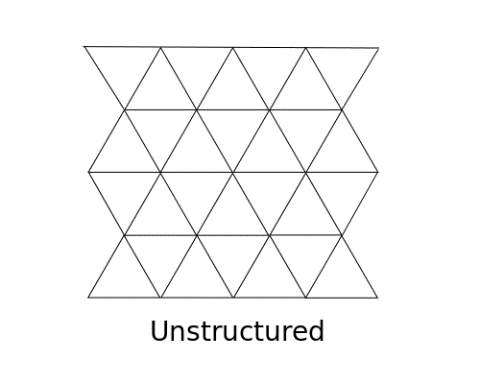 Finite element is the small volume surrounding each node referring to a mesh. In this FVM method, integrals of volume through partial differential equation (PDE) which has a convergence part are converted to surface integrals by means of the divergence theorem. These parts are measured as fluxes on the surface of every element volume. This method is conservative, because it is identical to that leaving the adjacent volume of the flux entering a certain volume. The FVM has many advantages, for example, it is easily to formulate to allow both structures and especially for unstructured meshes. In this way, the finite volume method is therefore suitable for some complicated meshes and complex
Finite element is the small volume surrounding each node referring to a mesh. In this FVM method, integrals of volume through partial differential equation (PDE) which has a convergence part are converted to surface integrals by means of the divergence theorem. These parts are measured as fluxes on the surface of every element volume. This method is conservative, because it is identical to that leaving the adjacent volume of the flux entering a certain volume. The FVM has many advantages, for example, it is easily to formulate to allow both structures and especially for unstructured meshes. In this way, the finite volume method is therefore suitable for some complicated meshes and complex 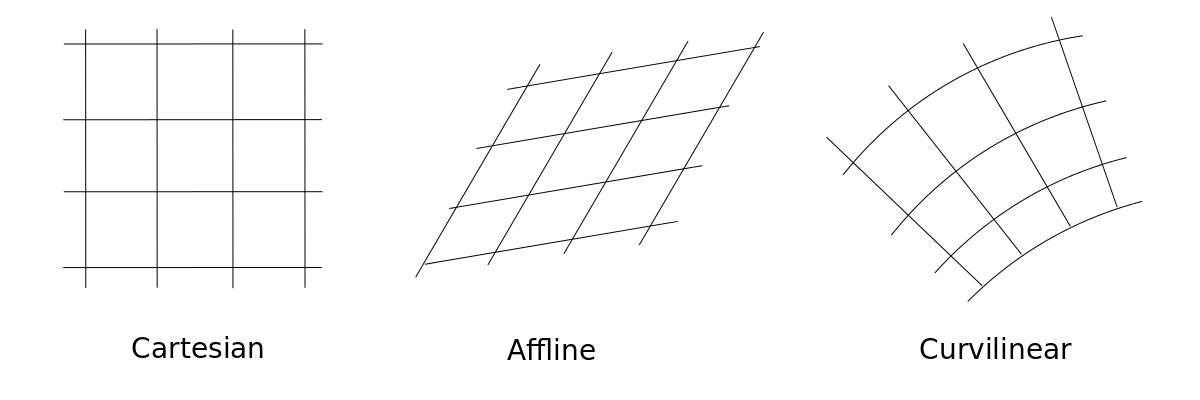
geometry.
Figure 3: 2D Structured Grid examples
FEM (Finite Element Method) is a numerical method for solving mathematical and engineering problems which is usually applied in the structure solid problems, but due to its advantage of good calculation accuracy it is applied to the N-S equations and is used in the Fluid problems as well. One the advantages of FEM is more stable in the iterations than FVM. But FEM need much more computer memory and running time than FVM method. A weighted residual equation is applied in this method:
(Where the R is Residual, Q is the conservation equation, and W is the weighted factor, and V is the Volume of this Element)
In the Computational Fluid Dynamics, the Naiver-Stokes equation is the most important equation describing how the viscous fluid substances moves in the domain. It is useful because some fluid phenomenon which people interested in can be described in this equation. Continuity Equation, Momentum equation and energy equation are the key components in the Navier-Stokes Equations. Generally speaking, the N-S equations are based on Mass Conservation, Momentum Conservation and Energy Conservation. All the N-S equations are from these 3 conservation rules.
The N-S equations have a continuity equation of Mass Conservation which is depended by the time variable (t), 3 momentum equations depended by the time variable and 1 energy equation from energy conservation. There are 4 independent variables in these equations which are X, Y and Z components as well as t (time) variables. 6 dependent variables are in these equations as well. They are u, v and w vector components in the direction of X, Y and Z separately and density (rho), pressure (P) and Temperature (T) in the Fluid domain. All these dependent-variables are of functions to the 4 independent variables which can be expressed in a form of PDE equations below:
We break it down—delivering each part on time with consistent quality. From proposals to final drafts, we’re with you all the way.
 Continuity:
Continuity:
(Mass Conservation)
X-Momentum:
Y-Momentum:
Yep! Whether it’s UK, US, or Australian rules, we adapt your paper to fit your institution’s style and expectations perfectly.
Z-Momentum:
Energy:
The governing Equation for compressible flow in Cartesian coordinate
Mass Conservation:
X-Momentum:
The moment you place your order, we jump into action to find the perfect writer for you. Usually, we’ve got someone lined up within an hour. Sometimes, though, it might take a few hours—or in rare cases, a few days—if we need someone super specialized. If no writers from your chosen category are free, we’ll suggest one from a lower category and refund the difference if you’d paid extra for that option. Want to keep tabs on things? You can always peek at your order’s status on your personal order page.
Y-Momentum:
Z-Momentum:
Energy:
The governing Equation for incompressible flow in Cartesian coordinates
 The dissipation function of the energy function is given by:
The dissipation function of the energy function is given by:
These equations above are of 3-Dimensional unsteady form of N-S equation and they are derived by George Gabriel Stokes and Claude Louis Navier in the year 1800 in the England and France. These equations describe the relationships between the temperature, velocity and density of a fluid. These equations are very complex thus at current stage of undergraduate only basic forms of Continuity, Momentum and Energy equations are described. Those equations with fully derivation will not be considered in this report because it is more essential to discuss the application of CFD rather than a fully theory of CFD. These equations are a series of Coupled PDE (Partial Differential Equation) and could be applied to the physical Fluid problems by means of different methods of mathematics. However, these PDE s are so hard to solve analytically that scientists in the past had to do some simplification and essential modification to these equations in order to solve these equations. Recently, the calculation of these equations become easier than situations many years ago due to the help of Finite element analysis methods mentioned above and development of high performance computer.
Usually the aerodynamics force of ground vehicles includes 2 types: pressure drag and friction drag. The pressure drag is the force acted perpendicular to the driving direction due to the pressure difference between head and rear part of the lorry while friction drag is formatted due to the shear stress between the surface of lorry and air. For a typical commercial lorry, the pressure difference head of tractor and rear of trailer can be vast, which causes a significant pressure drag. As R.M. Wood said in his book Impact of “advanced aerodynamic technology on transportation energy consumption [5]”: nearly 90% of the drag is made of pressure drag. Form some literature finding, it is possible to say that shape of tractor, gap between the trailer and tractor can be the dominant drag factor, as well as the complex geometry of trailer base.
Although most of the modern typical commercial Lorries are well designed, some conventional Lorries which is lack of aerodynamics consideration are still in use now. One typical problem in aerodynamics of traditional lorry is huge flow separation at upper corner part of the tractor. This separtion of flow will increase the pressure difference at this region and therefore reduce the streamlines of flow around tractor.
Without Deflector
With Deflector
Figure 4 a: Without Deflector
Figure 4 b: With Deflector
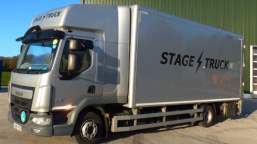 The gap between the tractor and trailer is a significant factor influencing the Drag. When the lorry is moving at a speed, the air hits the trailer front and then goes into the gap, which will format a pressure drag. If the height difference between the tractor and trailer is great, the pressure drag will be greater as well. The pressure drag will increase dramatically especially when cross wind situation appears. There are some common add-ons used to lead the air through gap space. The first one is, as mentioned above, the deflector is one of the best ways to avoid huge flow separation. Another way to improve aerodynamics is adding a side deflector especially for huge gap. The main purpose for these add-ons is to prevent the un-controlled circulation in the gap and cross flow as well. Both flow types will harm aerodynamic performance during the driving condition.
The gap between the tractor and trailer is a significant factor influencing the Drag. When the lorry is moving at a speed, the air hits the trailer front and then goes into the gap, which will format a pressure drag. If the height difference between the tractor and trailer is great, the pressure drag will be greater as well. The pressure drag will increase dramatically especially when cross wind situation appears. There are some common add-ons used to lead the air through gap space. The first one is, as mentioned above, the deflector is one of the best ways to avoid huge flow separation. Another way to improve aerodynamics is adding a side deflector especially for huge gap. The main purpose for these add-ons is to prevent the un-controlled circulation in the gap and cross flow as well. Both flow types will harm aerodynamic performance during the driving condition.
Gap Treatment
Figure 4 c: Gap treatment
Because of a lot of irregular geometries with shape edges existed on the surface under the tractor and trailer, some unexpected turbulent flow is therefore formatted under the lorry. These turbulent floe will reduce the streamlined flow under lorry and at the same time increase both pressure drag and skin friction drag. With the rotation of the wheels, flow separations become more complex. As a result of these effects, some energy will loss while driving at high speed. In order to reduce these negative influence on the lorry drag, some different types of devices are designed such as Side Skirts and Bogey Wheel fairing. All these devices are to make the bottom of lorry as smooth as possible and reduce the side-effect of the rotating wheels.
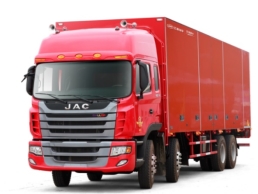

Another method to make flow around trailer more streamed is a devices called aerodynamics Teardrop. This is a modification of the shape of top surface of trailer. A conventional trailer surface is a flat surface which will leads to the formation of base wake and huge flow separation in the region near the front trailer edge. However, after this aerodynamics teardrop is applied to the lorry, more streamlined flow passing through the trailer is produced and therefore reduce the pressure drag as well as the total drag of the aerodynamics drag.
Conventional Trailer
Teardrop
Figure 4 d: With Teardrop
Figure 4 e: Original lorry
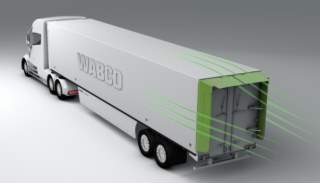
When the lorry is driving, the air flow passes through both top trailer surface and side surface and then these flows which are of low momentum meet at the rear trailer part. The interaction of these flows will generate a significant wake or called as Vortex, resulting an uncertain turbulent flow in the end of the trailer. As a result of these components, a low pressure region is formed which results in a big pressure difference and pressure drag. The normal devices to reduce the formation of these vortex and wake are Frame Extension, Base plate and Boat tail, etc. By leading the air flow along the Frame Extension, the flow separation could be decreased and strength of Vortex as well.
Frame Extension
Figure 4 f: With Frame Extension
As mentioned before, this report focus on studying the aerodynamics performance of the flow around a typical heavy commercial lorry. The preferred commercial CFD software is ANSYS-FLUENT. In fact, there are several commercial CFD analysis software for use right now such as ANSA, STARCCM+ and CFX. But in this case, ANSYS-FLUENT is used to investigate the flow patterns and measure the aerodynamics factors like Drag coefficient, Lift coefficient and so on. In this case, the Solidworks is utilised to sketch a 3D model of a typical commercial lorry.
In this case, the original plan is to choose a typical 3D lorry model of Volvo-company. Unfortunately, due to the security reason of Volvo Company, the author is not allowed to use a real Volvo Lorry. In order to achieve an accurate geometry of a typical lorry, a 3D lorry [7] form a commercial website called GrabCAD is used. This 3D model not only provides all features of a real lorry but it is of 1:1 Scale to a real heavy size as well. Thus, it is possible to say that this lorry model can represent a typical commercial heavy lorry which is in used now.
Figure 5: Lorry Geometry
Although this 3D lorry form GrabCAD have similar features of a real commercial heavy lorry, it is not recommended to apply this 3D lorry into FLUENT for analysis. Instead, a new simplified 3D lorry of 1:4 Scale with similar basic dimensions of the real lorry model is sketched in Solidworks. The new sketched lorry model has basic geometry of real lorry. But some complex geometry which does not influence much of the flow patterns such doors is neglected. Similarly, some complex parts like bottom of tractor and trailer is too complex to analysis. Besides, it is not necessary to spend a lot of time and resource in doing analysis of this part in the current case.
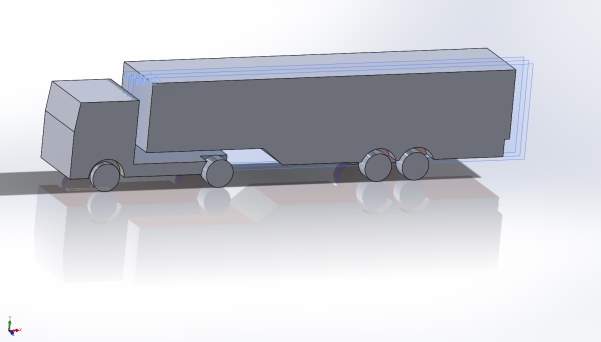
There are some reasons of doing a 1:4 smaller Scale simplified geometry. The first reason is due to the limited computing resource used for students. Generally speaking, the more complex the geometry is, the more difficult to generate a proper mesh for this lorry and more difficult for the FLUENT to converge even if a proper Turbulent Model is utilised. For example, in this case, the bottom of both tractor and trailer is so complex that it would take *5 times more computing resource than simplified model. The second reason is this lab focus on studying the main flow pattern around typical lorry and measuring the drag on the lorry, rather than investigating details of flow at some typical complex geometry. The simplified lorry geometry still keeps the main geometry but reduced some complex geometry which can be ignored for the purpose of this lab, so it would not change the major flow types around the lorry but decreased the meshing difficulty and increased computing efficiency at the same time. The last reason is due to mesh quantity of a full-size lorry. A full-Scale size lorry (about 16 meters long, 4 meters high, 3 meters wide) can generate over 10 million meshes even for this simplified lorry model which is not affordable in this case for student. Instead, a 1:4 Scale model is generated in order to decrease the cell numbers.
Figure 5a: Original Lorry Geometry
This picture above is the sketched 1:4 typical commercial lorry.
In this report, not only the original lorry is investigated, but Lorries with modifications which provide better aerodynamic performance are required to be tested as well. As mentioned above, there are several devises can be added to a lorry in order to produce more streamlined flow around the lorry. However, due to the limitation of both time and computing resource, this report focus on only 3 devices of add-ons.
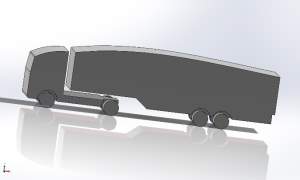
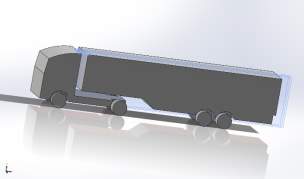
You Want The Best Grades and That’s What We Deliver
Our top essay writers are handpicked for their degree qualification, talent and freelance know-how. Each one brings deep expertise in their chosen subjects and a solid track record in academic writing.
We offer the lowest possible pricing for each research paper while still providing the best writers;no compromise on quality. Our costs are fair and reasonable to college students compared to other custom writing services.
You’ll never get a paper from us with plagiarism or that robotic AI feel. We carefully research, write, cite and check every final draft before sending it your way.